Ents,
Last winter, I stopped briefly at Cliff Creek and quickly
located new
state height records for sourwood, 95.3', and shortleaf pine,
135.7'.
The impressively rapid growth of hemlock and white pine in the
area
hinted at further finds in the area, but lack of daylight forced
an
early end to measuring that day. Recently, Will Blozan and I
returned to
the site to follow-up on a promising start. This time we had
nine hours
to explore the site, and found proportionally more record
heights.
We drove south from Clayton Georgia across the rolling terrain
of the
lower Chattooga River watershed, and admired the sea of virginia,
shortleaf, and white pine that blankets the area. Some stately
shortleaf pines beside the access road reached around 120', and
started the day on a promising note. The road ended at a turn
around
on the Cliff Creek watershed divide, and we dropped off the
ridge into
a shallow drainage. At first, we walked through a recovering
clear-cut, but soon found ourselves in a mature, second-growth
hardwood forest. White oak dominated the canopy with scattered
other
hardwoods and pockets of shortleaf pine, and scattered dogwood,
small
chinquapins, mountain-laurel, and dwarf rhododendron filled in
the
understory. The herbaceous layer was generally sparse, but
included
one colony of the rare three birds orchid (Triphora
trianthophora).
Beside the drainage, within 15 minutes of leaving the car, we
saw the
first height record of the
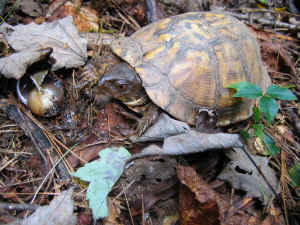 Turtle eating a snail
Turtle eating a snail
day, a skinny southern red oak reaching up 119.8'. Within sight
of
that tree, a slim scarlet oak reached 124.5' edging out a
massive tree
a little farther south for the species' state height record.
After
measuring a couple more trees along the drainage, we came to
Wolf
Creek, a tributary of Cliff Creek, and there a southern
crabapple
(Malus angustifolia) surprised us. The tree stretched
54.8' above the
turn-around circle on a logging road providing a bench mark for
this
under-measured species.
After crossing Wolf Creek and another prettily cascading
tributary, we
reached our primary objective, the gentle slopes and alluvial
flats
along the north side of Cliff Creek. Contrasting with the gentle
uplands, steep slopes consistently flank the south side of Cliff
Creek
and shelter the flats on the opposite bank. The creek produced
those
slopes by downcutting in response to the stream capture and
associated
base level reduction of the nearby Chattooga River. Even though
only
1200' in elevation and at the southeastern edge of hemlocks
range, the
creek supports a dense canopy, up to about 120' height, of
young,
rapidly growing eastern hemlocks, still largely and surprisingly
free
of adelgid. Shortleaf pine, mockernut hickory, tuliptree, and
sourwood grow scattered among them, and white pine occasionally
towers
above. While rosebay rhododendron blankets the north facing
slopes,
the understory and herbaceous layer on the south side is
startlingly
open and sparse for the southern Appalachians.
A few pockets of dog-hobble grew in the flats, but did not slow
us
done as we walked up the stream measuring trees as we went. Will
quickly honed in on
the tallest individuals of various species, and we gradually
built up
a Rucker Index for the area. He also spotted the tallest of the
sourwoods competing with the hemlocks, including a 103.9'
individual.
The nearby white pines in the flats exceeded 160'; certainly
impressive for the age of the trees, but not surprising given
the
heights the species attains on other creeks in the area.
As we proceeded up the creek, the forest composition shifted.
Large
hornbeams filled in the midstory, white pine became increasingly
common, patches of paw paw grew in the understory, spicebush and
christmas fern grew scattered about, and climbing hydrangea
vines
(Decumaria barbara) scaled the trees and creeped across
the forest
floor. These shifts
pointed towards increasing soil fertility, but conifers remained
dominant in the canopy. Not surprising, we saw white pine
heights
climbed slightly higher, and one fallen tree had an impressive
4'7"
internode, or one year's growth. At this point the creek made a
sharp bend
producing the first flats on the south side of the creek at the
base
of the slopes. We crossed the creek, shallow but up to about 40'
across, and found ourselves under a much more continuous white
pine
canopy. We lasered up into the consistently 150 to 165' trees as
we
walked up the creek and came to an impressive, unmarked cascade,
the
upstream end of our searches.
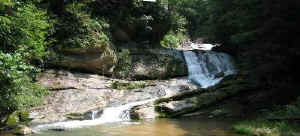
On the way
back down stream, we crossed
the creek and went up the slope to see if we could spot any
emergent
pines in the flats. Sure enough, one pine towered above the
adjacent
160' trees to a top 178.6' high! In under 100 years, the tree
grew
tall enough to be the second tallest known tree in Georgia, at
least for the
moment.
In the same vicinity, a contorted hemlock came up, bent back
underground, and apparently sent out new roots, or layered, and
sent
up two shoots that looked like independent trees. This tree
needs to
be checked to verify the connections between stems, but may
represent
a rare occurrence of layering for this species.
We traversed the creek again, and started exploring the
downstream end
of the flat on the creek's south side. We hopped over fallen
trunks
with three foot internodes continuing well up into the crowns,
and
continued measuring pines. Will measured one white pine that
produced
an initially startling result. I came over with a second
rangefinder and
clinometer set and confirmed the pine on only a 7'11" based
reached an
incredible 185.8' tall! The new tallest known tree in Georgia,
and
second tallest known tree east of the Mississippi!
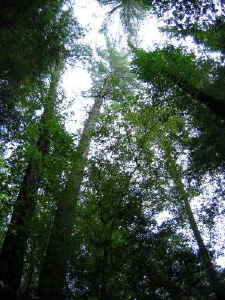 Crown of 185.8 foot white pine
Crown of 185.8 foot white pine |
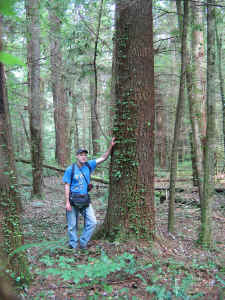 Will at base of 185.8 foot white pine
Will at base of 185.8 foot white pine |
In a somewhat
stunned state, we measured another pine in the
immediate
vicinity at 185.7'!
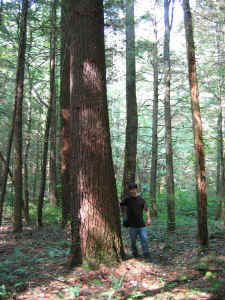 Jess and the 185.7 foot white pine.
Jess and the 185.7 foot white pine.
With the sun
sinking low, we walked back down the creek measuring a
few more towering pines as we went. We also stopped at an island
to
measure a beautiful 3'10" x 67.2' hornbeam with an immense
crown, a
potential new state champion.
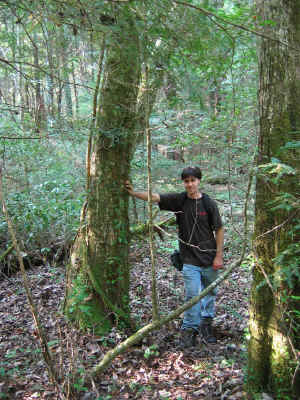
Jess and potential GA Champion Ironwood |
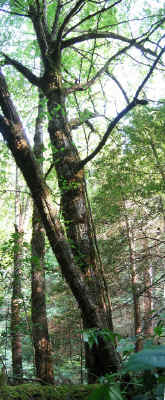 Ironwood Crown
Ironwood Crown |
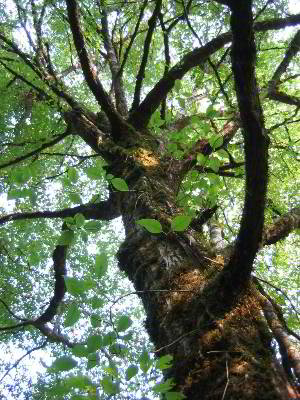 Mossy Ironwood
Mossy Ironwood |
Another tall hemlock along the
creek
brought the Rucker Index up to 135.84'; Panther Creek, a Brevard
Belt
site few miles to the south, has the highest Rucker Index in the
state
with ten hardwoods averaging just under 138'. The days
measurements
also approximately doubled the number of known 160 trees in the
state,
and suggest the upper flats on Cliff Creek support the tallest
forest
in the state.
A full list of measurements follows.
Species Cbh Height
Birch, Black NA 95.2'
Birch, Black 3'2" 99.6'
Birch, Black NA 102.9'
Crabapple, Southern 1'9" 54.8'
Dogwood, Flowering 1'6" 45.1'
Hemlock, Eastern NA 122.0'
Hemlock, Eastern NA 125.6'
Hemlock, Eastern NA 148.5'
Hickory, Mockernut NA 104.4'
Hickory, Mockernut 5'0" 127.3'
Hornbeam, American 1'8" 54.5'
Hornbeam, American 2'8" 61.4'
Hornbeam, American 3'10" 67.2'
Oak, Northern Red NA 114.2'+
Oak, Northern Red 6'5" 117.0'
Oak, Scarlet 4'5" 124.5'
Oak, Southern Red 4'2" 119.8'
Oak, White 7'9" 117.2'+
Oak, White 7'2" 122.4'
Paw Paw NA 39.0'
Pine, Eastern White 12'5" 149.9'
Pine, Eastern White 7'5" 158.3'
Pine, Eastern White 9'11" 159.4'
Pine, Eastern White 7'3" 161.2'
Pine, Eastern White 7'11" 161.6'
Pine, Eastern White 8'4.5" 162.7'
Pine, Eastern White 8'5" 162.7'
Pine, Eastern White 9'0" 164.6'
Pine, Eastern White 8'3" 168.0'
Pine, Eastern White 9'8.5" 169.1'
Pine, Eastern White 9'10" 169.7'
Pine, Eastern White 8'7" 170.7'
Pine, Eastern White 8'6" 176.6'
Pine, Eastern White 7'7" 178.6'
Pine, Eastern White 9'5.5" 185.7'
Pine, Eastern White 7'11" 185.8'
Pine, Pitch 6'8" 122.2'
Pine, Pitch 5'10.5" 125.2'
Pine, Pitch 4'2" 130.3'
Pine, Shortleaf 5'2" 124.7'
Pine, Shortleaf 5'9.5" 125.1'
Pine, Shortleaf 4'11" 133.0'
Pine, Shortleaf 5'2" 135.7'
Rhododendron, Dwarf 7.5" 15.7'
Sourwood 3'6" 96.7'
Sourwood 3'4" 103.9'
Sweetgum NA ~123'
Tuliptree 6'4.5" 141.1'
Eastern White Pine 185.8'
Eastern Hemlock 148.5'
Tuliptree 141.1'
Shortleaf Pine 135.7'
Pitch Pine 130.3'
Mockernut Hickory 127.3'
Scarlet Oak 124.5'
Sweetgum ~123'
White Oak 122.4'
Southern Red Oak 119.8'
Rucker Index 135.84'
I hope everyone and their families came through the recent
storms
alright, and that you all have been able to enjoy a happy and
safe
Labor Day.
Jess Riddle & Will Blozan
|